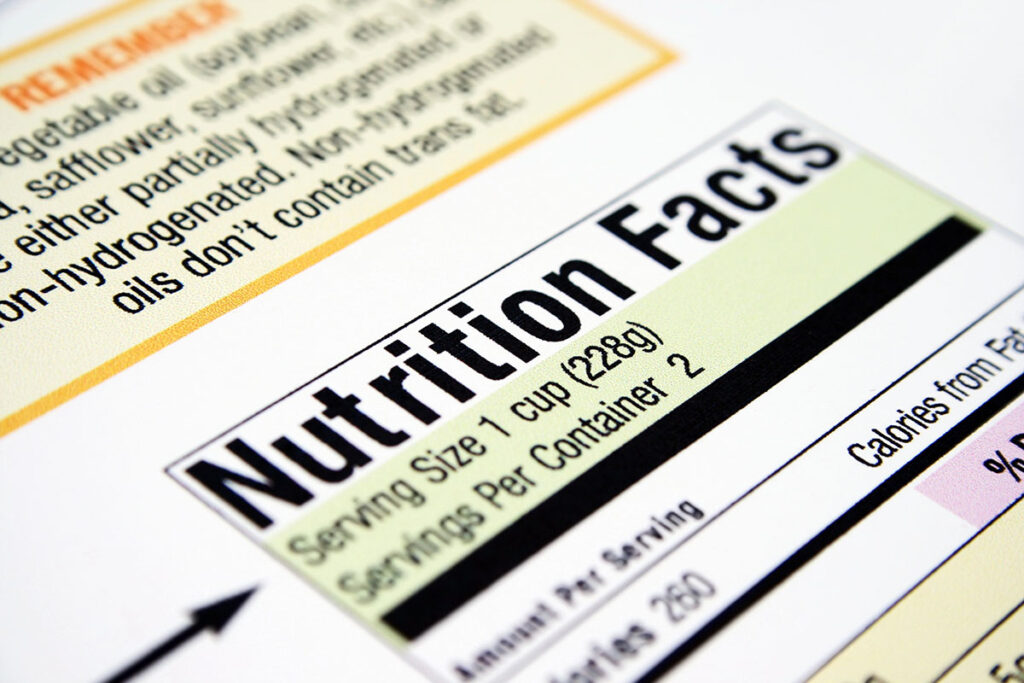Lightning Fast Turnaround!

When creating Austin food and drink labels, providing clear and precise nutrition information is vital for consumer trust and regulatory compliance. The FDA sets strict standards for food labeling to make sure manufacturers deliver accurate, standardized details. The Nutrition Labeling and Education Act of 1990 established the foundation for these guidelines, outlining exactly how Nutrition Facts must appear on your custom labels. This ensures that your products meet legal requirements while helping consumers make informed dietary decisions.
While we don’t assist directly with verifying the accuracy and completeness of your nutrition labels, we wanted to provide you with a handy overview as a starting point; and, of course, we’re happy to print your labels when you’re confident they meet all requirements.
The serving size on a Nutrition Facts label is crucial as it determines the nutrient amounts listed. It helps consumers understand how much of the food is considered a single serving and how many servings are in the package.
Calories indicate the amount of energy they get from one serving of the food. This information is vital for managing daily calorie intake and making informed dietary choices.
Added sugars are sugars incorporated into the food during processing, while total sugars include both natural and added sugars. Monitoring added sugars is essential for reducing excess sugar consumption.
The % Daily Value shows how the nutrients in one serving contribute to daily diet based on a 2,000-calorie daily intake. It helps gauge if a serving provides high or low amounts of specific nutrients relative for consumer daily needs.
Pay close attention to Vitamin D and Potassium levels. These nutrients are essential for bone health, muscle function, and maintaining proper blood pressure. Many people do not get enough Vitamin D from sunlight or diet alone, so giving accurate information on your labels helps keep track of adequate intake.
Keep saturated fat and cholesterol consumption in check to reduce the risk of heart disease. Custom food labels break down these fats clearly and effectively so consumers know what they’re having. Sodium content also influences blood pressure and cardiovascular health. Understanding these nutrient values helps consumers make smarter, healthier food decisions.
Effective use of Front-of-Package (FOP) labels is integral for attracting consumers and conveying accurate nutrition information quickly. FOP labels distill essential details—such as calories, sugars, fats, or sodium— into an easy-to-read format, allowing customers to assess nutritional highlights briefly and compare products more efficiently.
When developing custom labels, it’s important to understand that health claims—any statements linking a product or ingredient to reduced disease risk—are tightly regulated. The FDA mandates that all health claims must be substantiated by credible scientific evidence and pre-approved to ensure honesty and prevent misleading marketing. This protects both your brand’s reputation and consumer trust.
Incorporating nutrient content claims like “low fat,” “high fiber,” or “reduced sodium” can help your product stand out, but these claims must adhere to strict FDA definitions. Accuracy here is mandatory; overstatements or misrepresentations can result in regulatory action or customer dissatisfaction.
By combining clear FOP labeling with compliant health and nutrient content claims, custom food and drink businesses can offer transparency, build consumer confidence, and support informed purchasing decisions. Always pair these simplified messages with a complete Nutrition Facts label, so your customers have the full context they need to choose your products with confidence.
Accurately disclosing allergen information is essential to building trust and consumer safety. The Food Allergen Labeling and Consumer Protection Act of 2004 requires that all packaged foods prominently declare major allergens—such as milk, eggs, fish, crustacean shellfish, tree nuts, peanuts, wheat, and soybeans—near the ingredients list. Clear allergen labeling helps your brand demonstrate transparency and responsibility, while empowering customers to make safe choices.
Equally important is providing precise expiration date information on your custom labels:
By incorporating clear allergen labeling and accurate expiration dates on your custom food and drink labels, you not only comply with regulations but also enhance customer confidence in your products.
In 2016, the FDA implemented significant changes to the Nutrition Facts label to better inform consumers about the nutritional content of packaged foods. These updates aimed to reflect current dietary recommendations and provide clearer information for making healthier choices.
Some key modifications included:
Food manufacturers were given until January 2020 to comply with these new regulations, ensuring that consumers have access to accurate and updated information on their custom food and drink labels.
Creating accurate and informative custom labels empowers your customers to make smarter, healthier choices every day. We highlight these integral insights:
Keep these points in mind as you design labels. Well-crafted labels aren’t just a marketing tool—they’re a means for promoting nutrition and well-being.
Understanding Nutrition Facts labels helps consumers make informed dietary choices by providing essential information about serving size, calories, added sugars, and nutrient content, which can impact overall health and nutrition.
The FDA regulates food labeling through laws such as the Nutrition Labeling and Education Act of 1990, ensuring that Nutrition Facts labels provide accurate and standardized information to help consumers understand the nutritional value of packaged foods.
Key components include serving size, calories, added sugars versus total sugars, and % Daily Value for nutrients. These elements help interpret how much of each nutrient is present and how it fits into a daily diet.
Monitoring these nutrients is crucial because Vitamin D and Potassium support vital bodily functions, while excessive intake of saturated fat, cholesterol, and sodium can increase risks for heart disease and other health issues.
FOP labels are simplified nutrition or health claims placed on the front of food packaging. These Austin custom labels impact consumer choices by making it easier to quickly identify healthier options or warnings about certain nutrients, guided by FDA regulations on health claims.
Allergen labeling ensures that consumers with food allergies can identify potential allergens in packaged foods easily. Differentiating between sell-by, best-by, and use-by dates helps consumers understand product freshness and safety for consumption. If you’re in need of quality label printing in Austin TX, be sure to contact us today to discuss your needs.
|
Uploaded
Failed
|
 |